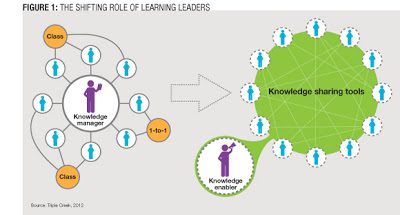Malcolm Knowles, a thought leader for adult learning theory, or andragogy, and author of The Modern Practice of Adult Education: Andragogy Versus Pedagogy, argued in the 1970s that as people mature, they become more motivated to learn based on internal drivers, such as their own personal desire to learn, rather than external drivers, such as someone telling them they need to learn. He postulated that as people age, experience becomes an increasing resource for learning, and that people seek to apply new insights immediately to solve problems.
With this framework for adult learning theory in mind, who is best suited to decide what employees learn today — the company and learning leaders or the individual employees?
A Shifting Landscape
Corporate training is in the middle of a major transformation, according to David Mallon, learning analyst and vice president of research at consulting firm Bersin & Associates. Mallon said the centralized, program-centric, university model of learning used by many organizations is shifting to an integrated “capability development” function that understands formal learning, informal learning, social tools, expertise networks and performance consulting. “This transformation is as big as the e-learning era that hit the market around 2000,” he said.
This shift in learning is largely based on what people view as their competitive advantage in business. John Hovell, leader of learning operations and technology for multinational defense, security and aerospace company BAE Systems Inc., said more organizations realize that competitive advantage comes from knowledge, and no longer from spending power or market share. “This shift is resulting in individuals and organizations thinking and operating differently,” Hovell said. “We are seeing some organizations and some leaders taking risks and giving up control to allow individuals to drive their own learning. Those organizations are reaping rewards of increased trust, high morale and inclusion, not to mention increased financial profits.”
The learning leader’s role is no longer that of a knowledge broker or manager — it’s an encourager and enabler of knowledge exchange (Figure 1). Organizations that can move from being keepers of content to being facilitators of learning connections will thrive in the 21st century. As more millennials swarm the workforce, it will be imperative to support them with the type of learning connections they have come to expect through their schooling — free-form networks where people come together to solve problems.

Yet, putting control of learning in the employees’ hands may seem unsettling to some learning leaders, who ask: How will we know if someone is actually learning something if we use informal methods? How do we know the information will be correct? How do we ensure that only the best resources create the information? “These questions are more pervasive in larger organizations and in companies that work in traditionally regulated industries, such as health care or aerospace,” Mallon said.
How does he respond to such inquiries? “As the former head of learning at British Telecom, Peter Butler, eloquently put it when he spoke about the company’s Dare2Share program at Bersin’s IMPACT 2010 Conference: ‘Get over it,’” said Mallon. “As much as 70 to 80 percent of learning in organizations is informal, so any perceived control that might have existed only accounted for a small fraction of the learning taking place in the company.”
Companies that try to control learning options often miss the mark and don’t provide the types of training and experiences their employees actually need. It is common for organizations to survey employees, find out that people want more development opportunities, and then misinterpret that as a need for more training. This is actually a cry for the right training and learning options. Employees want to have more options and methods for relative learning where they can connect with colleagues and learn from those around them within the context of their jobs. They want to be able to control what they learn and where they go for those insights.
What Learning Leaders Should
Stop, Start and Continue
“Learning leaders should rethink what needs to be controlled,” said Mallon. “Discover the natural flows of knowledge in the organization, find ways to support and improve those flows, and cultivate the type and quality of knowledge that the organization needs.” This allows companies to still be involved in helping their employees learn and gain skills, but in a way that is more beneficial to all parties.
“Every organization has its mandated, compliance-related needs, but part of the transition to a modern, high-impact learning organization is thoughtfully and honestly separating the few — and our research shows that they are few — learning needs that must be formally created, delivered and tracked from those for which such trappings are at best unnecessary and at worst in the way,” said Mallon.
Once companies get over the fear of giving up control and allowing individuals to decide what they learn, the results can be significant. “Learner-centered approaches are not only more cost-effective, but they produce better results,” said Hovell of BAE Systems.
Putting this into action can be as easy as following a few simple steps.
The Stop-Start-Continue model can help learning leaders who want to step out of their comfort zone and put learning in individual employees’ hands. This tool can help them figure out what they should stop doing because it isn’t working, what they should start doing that they aren’t and what they should continue doing because it is working well (Figure 2).

Stop feeding the content beast. “There are 95 million tweets per day, 152 million blog posts on the Internet, and each day more video is uploaded to YouTube than the three major television networks created in the past 60 years,” said Jeanne Meister, co-author of The 2020 Workplace: How Innovative Companies Attract, Develop & Keep Tomorrow’s Employees Today and partner in Future Workplace, an executive development firm. Learning leaders need to be realistic and ask themselves a tough question: How much e-learning and online training content do we have sitting on the shelves that no one uses or that is outdated? The answer is likely too much.
Content is not the solution, and managing vast amounts of static content is not the best use of learning leaders’ time or energy. “Information management is very different from knowledge management,” Hovell said. “Information management is ensuring that information is available, accurate and flowing in the organization. On the other hand, knowledge management is about optimizing the flow of knowledge, which is very different from the flow of information.” Learning leaders need to stop wasting their time on information management. Their expertise and energy are better used elsewhere.
Start encouraging collaboration and generative learning connections. This is where learning leaders should spend their time. “Employees are often fearful in their first usage of internal social networks if they are not aware of the company’s social media policy and guidelines, and have not been trained in what and how to share in a responsible and respectful manner,” Meister said. Learning leaders have a responsibility to enable and support employees to connect with one another in various ways so they can learn from each other and share insights with the crowd through internal social networks, online mentoring programs or in-person networking events.
“Social and embedded learning are baked into the organization in ways that formal learning will never be,” Bersin & Associates’ Mallon said. “These forms of learning are, in that sense, more natural and more performance-focused. Using the language of Bersin’s Modern Enterprise Learning Index (a set of 10 indicators of overall readiness for learning organizations transitioning to next-generation, high-impact learning), they are implicitly more proximal, versatile, adapted and targeted.” Supporting employees so they can engage in meaningful knowledge sharing across the enterprise is a vital role learning leaders must play.
Continue to recognize and reward the productivity gains individuals make. According to Hovell, morale is the fastest-growing competitive advantage in companies today, and learning leaders can tap into this phenomenon. “Learner-centered learning approaches absolutely result in higher morale because people are empowered to guide their own lives and careers, as opposed to taking orders and destroying their value in creativity and curiosity,” Hovell said. “Profit-driven organizations will benefit from the creativity, innovation, trust and ingenuity that comes from learner-centered approaches.”
If learning leaders continue to acknowledge accomplishments people are making to gain critical skills, knowledge and capabilities, they will be able to make meaningful strides in their quest to put more power and control in individual learners’ hands.
“It has been said that many companies hire the smartest people they can find and then they treat them like idiots,” Hovell said. “If we simply give them the opportunity to guide their own learning and their careers, they will produce amazing results.”
Randy Emelo is president and CEO of Triple Creek, an enterprise mentoring systems provider. He can be reached at editor@CLOmedia.com.
Who Runs Learning Anyway?
• Situations for employees to control learning
• Situations for companies to control learning
• Understanding a new practice.
• Building new skills and capabilities.
• Expanding knowledge of other functions.
• Certification-based training.
• Compliance training.
• Establishing organizational culture/behaviors
Find out why making employees co-owners of engagement may be one of the wisest things you can do here.
















